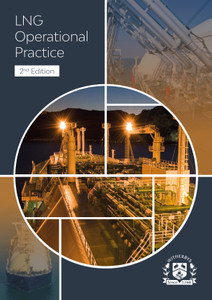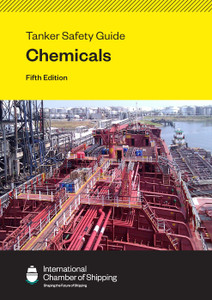
Chemical Tanker Notes & Operational Practice - 2nd Edition
This publication provides detailed guidance on chemical tanker operational practice, from loading through to voyage and discharge operations. It includes detailed recommendations and guidance on chemical transportation by sea, as well as aspects such as cargo planning, tank cleaning, loading, conditions of carriage, ballasting and discharge.
This update incorporates practical guidance from a group of experienced, currently serving chemical tanker chief officers. This edition includes over forty expanded case studies ranging from examples of load calculations to correct use of Ship/Shore Safety Checklists.
The appendices provide useful reference material on chemical compounds, storage compatibilities, IMO regulations, Shipboard Marine Pollution Emergency Plans (SMPEP), the P&A Manual and cargo lists.
The second edition has been extensively revised and updated to reflect current best practice in chemical tanker operations. This includes updates to procedures and recommendations for cargo carriage, which reflect the latest regulatory requirements. These primarily include updates to the International Code for the Construction and Equipment of Ships carrying Dangerous Chemicals in Bulk (IBC Code) and the MARPOL Convention.
The book looks in turn at every stage of a chemical voyage, including:
- The importance of product identification and how this affects stowage, segregation and handling.
- Creating a load plan and assessment of cargo related risks, with regards to the hazards of chemicals such as noxious liquid substances.
- Methods of tank cleaning, tank washing mediums and testing standards for cargo tanks.
- Loading operations, including information on loading rates and temperatures, sampling, cargo calculations, deballasting and vapour return systems.
- Guidance on cargo calculations, recordkeeping and tanker related paperwork.
- Information on cargo tank coatings and cargo systems, including cargo pumps.
- Conditions of carriage and cargo care, including heated cargoes, nitrogen blanket cargoes, recirculation and inhibited cargoes.
- Preparations for arrival, including discharge procedures and ballasting.
- Prewash operations.
Preface to the Second Edition
This publication has been extensively revised and updated by Witherbys to reflect current best practice in chemical tanker operations. This includes updates to procedures and recommendations for cargo carriage as a result of changes to regulatory requirements. These primarily include updates to the the International Code for the Construction and Equipment of Ships carrying Dangerous Chemicals in Bulk (IBC Code) that are now reflected across this publication.
Recent amendments to the IBC Code include amendments to the contents of the model form of the Certificate of Fitness and NLS Certificates that entered into force on 1 January 2020 (Resolutions MSC.440(99) and MEPC.302(72)).
However, the most significant change for chemical tankers in recent years is the revised chapters of the IBC Code and amendments to MARPOL Annex II that entered into force on 1 January 2021 (Resolution MEPC.318(74)). These amendments required the revision and replacement of the ship's existing Certificate of Fitness as well as updates to the ship's P&A Manual. Specifically, these amendments relate to Chapters 1, 15, 16 (Operational requirements), 17 (Summary of minimum requirements), 18 (List of products to which the Code does not apply), 19 and 21 of the IBC Code.
The revision of Chapter 16 introduced prewash requirements, as per paragraph 13.7.1.4 of MARPOL Annex II, for persistent floating substances. This included amendments to the P&A Manual for new procedures relating to the cleaning of cargo tanks with persistent floating substances inside certain regions.
Importantly Chapter 17 now indicates with 'T' in column (k) whether a substance is considered a 'Toxic' substance. Over 200 cargoes were added in 2020 to the cargoes having the 'T' (denoting whether a substance is considered a 'Toxic' substance) in IBC Code column (k). It is also a requirement of the IBC Code that when a ship carries a toxic substance, a vapour-detection instrument must be on board. Many toxic cargoes will also have more stringent requirements to stowage and segregation away from oil fuel tanks, as well as additional requirements for cargo tank relief-valve settings than non-toxic cargoes.
These amendments were required to strengthen discharge requirements for cargo residues and tank washings from ships carrying NLS. The amendments therefore harmonise the list of substances and also upgrade/downgrade the ship type requirements for a number of different cargoes. Furthermore, some cargoes that were listed in Chapter 18 (list of products to which the code does not apply) have moved to Chapter 17 and will no longer be allowed to be carried on ships that do not have the required Certificate of Fitness.
Finally, another recent set of amendments to the IBC Code that are due to enter into force on 1st July 2024 is those in Resolution. MSC.526(106). They relate to survivability and provide exclusions related to those openings fitted with watertight closures for application of the conditions concerning flooding or downflooding.
Tables
Case Studies
Preface to the Second Edition
Preface to the First Edition
About the First Edition Author
Chapter 1 - Transportation of Chemicals by Sea
1.1 Introduction
1.2 Chemicals and Their Properties
1.3 Chemicals and Their Hazards
1.4 Safety Data Sheet
1.5 Coatings, MARPOL and Cargo Categories
1.6 Ship Types and Cargo Containment
1.7 Transportation Requirements
1.8 Cargo Equipment, Safety Equipment and PPE
1.9 Industry Organisations
Chapter 2 - The Voyage and Cargo Planning
2.1 Voyage Orders
2.2 Cargo Planning
2.3 Stowage, Segregation, Compatibility and Coatings
2.4 Load Planning
2.5 Cargo Planning and Stability Considerations
2.6 Passage Planning
2.7 ETA and Notice of Readiness
Chapter 3 - Tank Cleaning
3.1 Cleaning, Slop and Disposal Procedures
3.2 Tank Cleaning Recommendations
3.3 Tank Cleaning with a Cleaning Agent (additive)
3.4 Tank Cleaning by Ventilation
3.5 Tank Cleaning by Steaming
3.6 Draining and Drying
3.7 Inert Gas and Inert Gas Generator
3.8 Tank Cleaning Plan and Team Meeting
3.9 Tank Cleaning Equipment
3.10 Preventing Unauthorised Discharge
3.11 Visual Inspection of the Tank
3.12 Wallwash Tests
3.13 Preload Tests and Checks
Chapter 4 - Loading and Departure
4.1 Preparations and Precautions
4.2 Tanks Inspection
4.3 Pre-Cargo Meeting and Connection of Manifolds
4.4 Stability During Cargo Operations
4.5 Loading
4.6 Ballast Operations
4.7 Cargo Tank Vapour Return Systems
4.8 Emergencies During Cargo Operations
4.9 Loading Rate and Loading Temperature
4.10 Sampling
4.11 Cargo Completion and Calculation
4.12 Cargo Discrepancy
4.13 Short Loading
4.14 Letter of Authorisation
4.15 Bill of Lading
4.16 Statement of Facts and Timesheets
4.17 Departure
Chapter 5 - Conditions of Carriage
5.1 Heated and Cooled Cargoes
5.2 Nitrogen Blanket Cargo
5.3 Recirculation
5.4 Polymerisation/Inhibited Cargo
5.5 Phenol Cargo
5.6 Cargo Additives
Chapter 6 - Discharging
6.1 Considerations on Arrival
6.2 Pumps
6.3 Commencing Discharge
6.4 Stripping
6.5 Completing Discharge, Inspection and Blowing the Line(s)
Chapter 7 - Prewash
7.1 Prewash Requirements
7.2 Prewash Procedures
7.3 Minimum Quantity of Water Required for Prewash
7.4 Persistent Floating Products
Chapter 8 - Terms and Definitions
Appendices
Appendix 1 Compatibility Chart
Appendix 2 Alphabetical Listing of Compounds
Appendix 3 Exceptions to the Compatibility Chart
Appendix 4 FOSFA List of Banned Immediate Previous Cargoes
Appendix 5 FOSFA List of Acceptable Previous Cargoes
Appendix 6 International Certificate of Fitness for the Carriage of Dangerous Chemicals in Bulk
Appendix 7 NLS Certificate
Appendix 8 Procedures and Arrangements Manual
Appendix 9 Cargo Hose Record
Appendix 10 Shipboard Marine Pollution Emergency Plan (SMPEP)
Appendix 11 Guidelines in Developing a SMPEP
Bibliography
Index
Witherbys titles are developed using scripts developed by technical experts that are peer reviewed within work groups. Typically, they seek to improve understanding of the regulations, recommendations and guidelines issued by Industry.
Witherbys staff have significant expertise in the fields of navigation and hazardous cargoes as well as in the presentation of complex subjects in a graphic and easy to understand manner.
- Number of Pages:
- 332
- Published Date:
- October 2024
- Book Height:
- 305 mm
- Book Width:
- 220 mm
- Weight:
- 2 kg
- Publication Date:
- October 2024
- Author:
Witherbys





